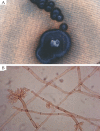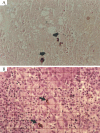Chromoblastomycosis: tissue modifications during itraconazole treatment
- PMID: 28954095
- PMCID: PMC5595593
- DOI: 10.1590/abd1806-4841.20175466
Chromoblastomycosis: tissue modifications during itraconazole treatment
Abstract
Background:: Histological and mycological changes during itraconazole use have not been totally established in chromoblastomycosis.
Objectives:: To evaluate tissue modifications in chromoblastomycosis carriers under itraconazole treatment.
Methods:: A histological retrospective study of 20 cases of chromoblastomycosis seen at the university hospital at the south of Brazil, during itraconazole 400 mg daily treatment. Patients were classified into two groups: plaque or tumor lesions, and underwent periodic evaluations every four months during three years. Hematoxylin-eosin stain was used to analyze epidermal modifications, inflammatory infiltrate and fibrosis, and Fontana-Masson stain for parasite evaluation.
Results:: Fontana-Masson stain was superior to hematoxylin-eosin stain in fungal count in the epidermis (mean difference=0.14; p<0.05). The most distinct mycosis tissue responses were registered in the dermis. Epidermal thinning, granulomatous infiltrate decrease or disappearance, fibrosis increase and quantitative/morphological changes occurred during treatment.
Study limitations:: Patients could not be located to have their current skin condition examined.
Conclusion:: Parasitic and tissue changes verified in this study can reflect the parasite-host dynamics under itraconazole action.
Conflict of interest statement
Conflict of interest: None.
Figures






References
-
- Garnica M, Nucci M, Queiroz-Telles F. Difficult mycoses of the skin: advances in the epidemiology and management of eumycetoma, phaeohyphomycosis and chromoblastomycosis. Curr Opin Infect Dis. 2009;22:559–563. - PubMed
-
- Queiroz-Telles F, Nucci M, Colombo AL, Tobón A, Restrepo A. Mycoses of implantation in Latin America: an overview of epidemiology, clinical manifestations, diagnosis and treatment. Med Mycol. 2011;49:225–236. - PubMed
-
- Correia RTM, Valente NYS, Criado PR, Martins JEC. Cromoblastomicose: relato de 27 casos e revisão da literatura. An Bras Dermatol. 2010;85:448–454. - PubMed
-
- López Martínez R, Méndez Tovar LJ. Chromoblastomycosis. Clin Dermatol. 2007;25:188–194. - PubMed
-
- Santos AL, Palmeira VF, Rozental S, Kneipp LF, Nimrichter L, Alviano DS, et al. Biology and pathogenesis of Fonsecaea pedrosoi, the major etiologic agent of chromoblastomycosis. FEMS Microbiol Rev. 2007;31:570–591. - PubMed
MeSH terms
Substances
LinkOut - more resources
Full Text Sources
Other Literature Sources
